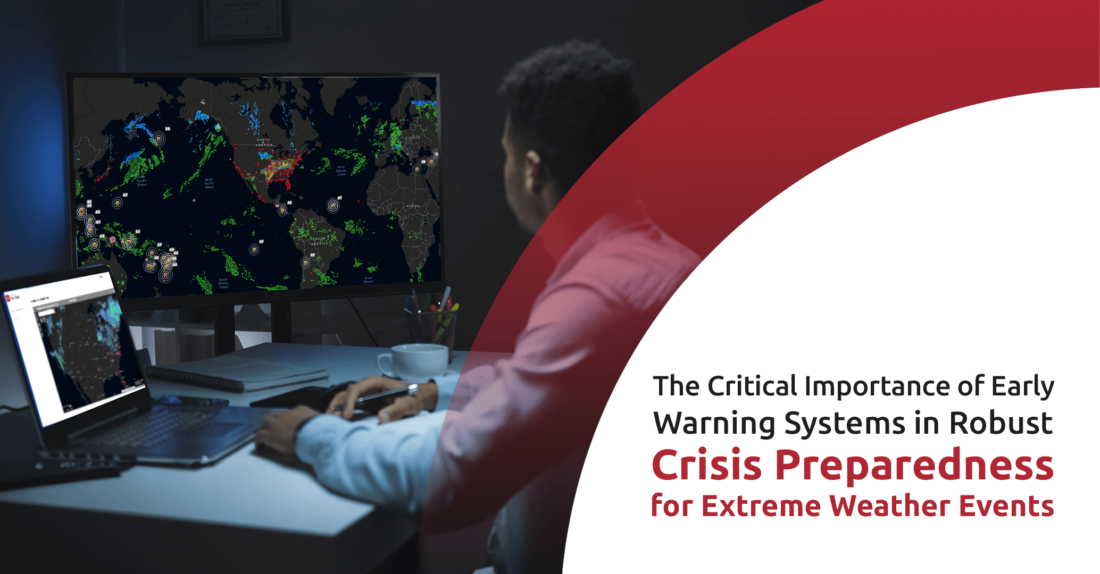
The Critical Importance of Early Warning Systems in Robust Crisis Preparedness for Extreme Weather Events
As our climate continues to change, extreme weather events such as hurricanes, tornadoes, and blizzards are becoming more frequent and intense. This trend poses significant risks to businesses worldwide, affecting everything from supply chains to safety protocols.
Early warning systems are crucial in mitigating these risks by providing timely alerts that enable proactive measures. These systems leverage advanced technology to predict and communicate potential dangers well before they occur, allowing businesses to minimize damage and protect lives. Understanding and integrating these systems into corporate safety and crisis management strategies can significantly bolster a company’s resilience against unpredictable natural threats.
Understanding Early Warning Systems
An early warning system (EWS) integrates technological tools and human resources to predict and respond to potential crises effectively. Key components include sensors for data collection, analytical software for interpreting data, and communication networks for disseminating alerts.
The process begins with the continuous monitoring of environmental data through advanced sensors and satellites, focusing on indicators of potential extreme weather events. This data is then analyzed using sophisticated algorithms designed to predict the likelihood and impact of such events. Once a threat is identified, the system disseminates alerts through multiple channels to ensure rapid and wide-reaching communication. This enables businesses and communities to take preemptive actions, such as evacuations, activating emergency plans, or securing critical infrastructure, thereby reducing potential damage and enhancing overall resilience.
These systems are crucial for businesses that are increasingly exposed to the adverse effects of climate change and extreme weather. By understanding and implementing robust early warning systems, organizations can safeguard their operations, assets, and human resources against unexpected natural disasters.
The Importance of Early Warning Systems in Crisis Preparedness
Early warning systems are pivotal in shaping robust preparedness plans before an extreme weather event occurs. These systems enable businesses to establish and refine emergency protocols and evacuation plans based on specific threat assessments. By providing early notifications, organizations have a better chance to mobilize resources, secure essential assets, and safeguard personnel, thereby minimizing potential disruption.
During an actual weather event, the value of real-time data cannot be overstated. Early warning systems provide continuous updates that are crucial for dynamic decision-making and effective resource allocation. This real-time information helps managers adjust strategies in response to changing conditions, direct emergency services more effectively, and communicate timely and accurate warnings to those in harm’s way. The ability to adapt to the situation as it unfolds drastically reduces the impact on operations and enhances the safety of all stakeholders.
The integration of early warning systems into business operations transforms the approach to crisis management, moving from reactive to proactive. This shift not only saves lives but also preserves the economic stability of the business, maintaining continuity even in the face of severe weather challenges. The strategic implementation of these systems is an investment in resilience, ensuring that businesses are not only prepared to face current challenges but are also equipped for future adversities.
Integrating Early Warning Systems with Business Continuity
Integrating early warning systems into business continuity plans is essential for enhancing organizational resilience against extreme weather events. By embedding these systems into their strategic framework, businesses can ensure that they are not only prepared to react to immediate threats but also equipped to sustain operations under adverse conditions. This integration helps in identifying critical assets, prioritizing protection efforts, and ensuring that response mechanisms are seamlessly activated during crises, thus minimizing operational disruptions.
Investing in early warning systems may seem costly at first glance, but when weighed against the potential losses from unmitigated disaster scenarios, the benefits are substantial. These systems can significantly reduce downtime, protect infrastructure investments, and safeguard human lives, potentially saving millions in avoided damages and lost revenue. By analyzing past incidents and the role early warnings played in mitigating impacts, businesses can quantify the value derived from their investment. This analysis not only justifies the initial expenditure but also highlights the importance of early warning systems in maintaining economic stability and continuity in the face of natural disasters.
Businesses that effectively incorporate early warning systems into their continuity strategies not only bolster their resilience but also enhance their capability to thrive post-crisis. This proactive approach ensures that companies are not merely surviving disasters but are also positioned to capitalize on post-crisis opportunities, thereby turning potential threats into strategic advantages. This strategic integration not only secures the enterprise in terms of operational continuity but also contributes positively to its reputation and reliability in the eyes of stakeholders, investors, and customers.
Challenges and Future of Early Warning Systems
Technological Challenges
Despite their undeniable utility, early warning systems face several technological challenges. Limitations in data accuracy, timeliness, and coverage can hinder the effectiveness of these systems. Issues such as sensor reliability, network connectivity in remote areas, and the integration of disparate data sources remain significant hurdles. Furthermore, ensuring the interoperability of global systems to facilitate seamless data exchange and response coordination is complex. Addressing these challenges requires ongoing investment in technology upgrades, research, and development to enhance system robustness and reliability.
Innovations on the Horizon
The future of early warning systems looks promising with several technological advancements on the horizon. Innovations in artificial intelligence and machine learning are set to revolutionize how data is processed, enabling more accurate predictions and personalized alerts. The development of more sophisticated sensors and the expansion of IoT devices can provide more granular, real-time environmental monitoring. Additionally, the integration of big data analytics will improve the predictive capabilities of these systems, allowing for earlier and more precise warnings. A great example of an advanced early warning system is EarlyAlert’s SmartSuite Situational Awareness, which provides precise, accurate, and real-time actionable insights, for robust resilience against all hazards. As technology evolves, the potential for creating more resilient communities through enhanced early warning systems grows, offering hope for better preparedness against extreme weather events.
These developments not only promise to overcome current limitations but also open up new capabilities for early warning systems. By staying at the forefront of technology and continuously adapting to new challenges, businesses can ensure that their early warning practices remain effective and efficient, safeguarding assets and lives against the unpredictability of extreme weather. The commitment to evolving these systems is crucial for sustaining and enhancing global resilience to environmental threats.
Actionable Steps for Businesses
Implementing Early Warning Systems: For businesses aiming to enhance their crisis preparedness against extreme weather events, implementing an early warning system starts with understanding specific environmental threats relevant to their geographic location and industry. Firstly, invest in reliable weather monitoring tools, such as EarlyAlert’s SmartSuite Situational Awareness platform, that offer real-time data tailored to your business needs. Establish partnerships with meteorological services and technology providers to ensure access to the latest advancements and data insights. Integrate these systems with internal communication networks to ensure swift dissemination of alerts.
Infrastructure and Technology Integration: Adapt your infrastructure to facilitate seamless integration of early warning technologies. This includes upgrading IT systems to handle large data flows and ensuring that communication channels are robust and redundant. Consider cloud solutions for better scalability and resilience in data handling. Implementing geographic information systems (GIS) can help visualize weather threats concerning business assets and operations, enhancing situational awareness.
Training and Exercises: Training employees is crucial for ensuring an effective response to early warnings. Conduct regular training sessions to familiarize staff with the early warning tools and their roles in emergency procedures. Simulate weather-related scenarios to practice evacuation, sheltering, and other safety measures. This helps in testing the effectiveness of communication channels and response strategies, promoting a culture of preparedness.
Continuous Improvement and Feedback: Establish a feedback loop where employees can contribute insights from drills and actual incidents, which can be used to refine the early warning system and response plans. Regularly review and update your plans based on new technological advances, changes in business operations, or lessons learned from past events. Engage with expert consultants in crisis management and meteorology to stay abreast of best practices and emerging trends.
By following these actionable steps, businesses can leverage early warning systems effectively, ensuring that they not only anticipate extreme weather events but also respond to them in a manner that minimizes risk and disruption, thus maintaining continuity and safeguarding their operations and workforce.
A Call to Action for Enhanced Resilience
The importance of early warning systems is crucial in fortifying businesses against extreme weather events. They provide crucial lead time, allowing for effective, strategic responses that safeguard both human and material assets. By predicting adverse weather conditions with precision, these systems enable businesses to enact their crisis management plans proactively, significantly mitigating potential damages and disruptions.
To navigate the complexities of extreme weather and ensure business continuity, it is critical to harness advanced early warning technologies. Partner with EarlyAlert to leverage our expertise in situational awareness to enhance their crisis preparedness strategies. Together, we can develop a resilient framework that not only predicts but also proficiently manages the challenges posed by extreme weather conditions.


Sorry, the comment form is closed at this time.